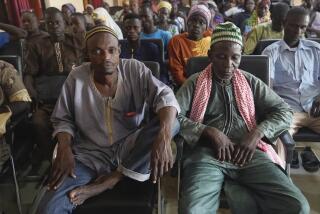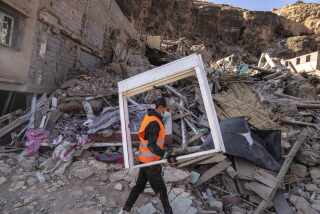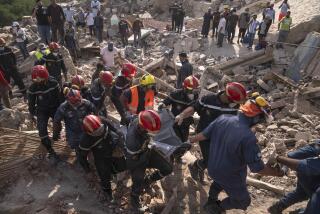In Morocco, an unlikely group of terror suspects
- Share via
RABAT, MOROCCO — They are politicians and businessmen, bureaucrats and pharmacists, a police commander and a TV journalist.
Police arrested them and seized an arsenal in nationwide raids this month, the biggest crackdown in Morocco since suicide bombings killed 45 people, including the 12 bombers, in Casablanca five years ago.
During the last week, Moroccans have clustered on rainy mornings around kiosks along this capital’s colonnaded downtown avenues, marveling at the latest newspaper reports on the case. The profile of the 35 suspects contrasts sharply with the Casablanca bombers, a dozen young men from a slum who assembled homemade explosives and died wearing identical wristwatches that were a last gift from their handler.
The recently arrested alleged leader of the group was a well-off Moroccan immigrant in Belgium who is accused of financing his activity with multimillion-dollar hold-ups and committing assassinations in that European country dating back 20 years. Moroccan Interior Minister Chakib Benmoussa said in an interview that the group plotted to assassinate Cabinet ministers, military chiefs and Jewish leaders to destabilize this moderate Muslim nation.
Benmoussa and other investigators say the alleged plot helps illustrate threats converging here. Morocco finds itself in the eye of a storm radiating across Europe, North Africa and the Middle East.
“The leaders of this network had the opportunity to train in Afghanistan, to meet leaders of Al Qaeda, and to go to Algeria to train in [rural outposts] in 2005,” Benmoussa said.
Some aspects of the case against the suspects perplex analysts. The three politicians arrested belong to small parties that mix Islamist and leftist ideologies. Their defenders say they are moderates.
Their longtime ties to Shiite Muslim movements, including Hezbollah, may have been a factor in their arrests. Sunni Muslims are the majority here, but authorities worry about the danger of extremism among the small Shiite minority and sympathetic Sunni radicals.
Sunni and Western governments fear that the recent assassination of a Hezbollah military chief in Syria could foment Shiite-inspired violence around the world, says Abdellah Rami, an expert on Islam at the Moroccan Center for Social Studies.
But Rami sees contradictions in the official version alleging that the Moroccan group of suspects was influenced by both Sunni-led Al Qaeda and Shiite Hezbollah.
“I find it hard to believe that all these movements were mixed together in the same cell,” said Rami, who knows the jailed politicians.
Authorities say they have documented connections, such as attempts to arrange training with Hezbollah in 2002. The jailed journalist, Abdelhafid Sriti, was a correspondent for Hezbollah’s Al Manar network. Al Manar has been banned from broadcasting in France, Spain and the U.S., which accuse it of airing extremist and anti-Semitic programming.
Western security experts agree that there are unanswered questions.
“It’s a real mix of things, kind of bizarre, but if everything is confirmed I think it is a big, big affair,” said Claude Moniquet, director of a Brussels think tank who works with the Moroccan government.
Morocco is relatively open and democratic, modernizing quickly and trying to reduce inequality. The monarchy promotes a tolerant Islam in which the king is the leader of the faithful, an effort to maintain a bulwark against extremism. But its geography makes it a gateway to Europe and a crossroads for migration, crime and extremism.
“The Moroccans have worked hard since Casablanca so they haven’t had more attacks,” said a Belgian anti-terrorism official who knows North Africa well. “But they have a lot of radicals to watch, guys going to Iraq who could come back. And there are all the problems [in countries] around them, like a sandwich effect.”
On the east, Algeria has endured a campaign of suicide bombings by Al Qaeda in the Islamic Maghreb, a network also blamed for recent gun attacks to the south in Mauritania on French tourists and the Israeli Embassy. The threat of extremist violence caused the cancellation last month of the annual Dakar Rally off-road race to have run from Portugal to Senegal. Next year it will be held in South America instead.
Meanwhile, Moroccan militants flow abroad for training and combat. Some fight in Iraq; some trek to clandestine training outposts in the deserts of southern Algeria and northern Mali, the vast and lawless Sahel region.
“We know that there are several pipelines that connect to Iraq, others to Algeria, others to the Sahel,” Benmoussa said. “Some of these pipelines function with the goal of creating a reserve of fighters down there. And others with the idea of training them to come back to Morocco. . . . What is going on in the Sahel worries us a great deal.”
Extremists benefit from a boom in Europe-bound cocaine along traditional smuggling routes, said Benmoussa, 49, who is an MIT graduate.
“It is a zone where there is a lot of money circulating, with cocaine traffic that is growing fast,” Benmoussa said. “A certain number of terror networks exploit this situation because these groups guarantee, secure the routes.”
Morocco feels vulnerable because it relies heavily on European tourism. Tourism dipped after the Casablanca attacks, but bounced back, reaching a record monthly figure of 1.2 million visitors last July.
The aggressive policing aimed at preserving a safe image spurs cooperation with foreign anti-terrorism agencies -- and periodic complaints of abuse. Authorities arrested Abdelkader Belliraj, 51, the alleged leader of the plot, last week while he was on a visit from his home in Belgium, where he lived comfortably with his wife and three children.
But Moroccan investigators say that during his youth, he was a hit man for a terrorist group led by the late Abu Nidal, a Palestinian and an Arab nationalist who later embraced Islamic extremism.
They accuse Belliraj of committing half a dozen killings in Belgium in the 1980s. The victims include a leader of Belgium’s Jewish community, the rector of a mosque and a Syrian diplomat, according to Belgian anti-terrorism sources.
In 2000, Belliraj’s group allegedly took part in stick-ups of Brink’s trucks in Luxembourg and Belgium that netted at least $24 million. About $5 million was laundered through Moroccan hotels and real estate, and was used to finance the group, police say. The sum dwarfs the usual budgets of Al Qaeda-linked cells.
Belgian police were caught off-guard by the Moroccan charges, the Belgian anti-terrorism official said. Though expressing some doubts, they have opened an investigation. If Belliraj was a major player, he avoided detection for a long time, the official said.
Benmoussa said several of Belliraj’s followers traveled to Afghanistan in 2001 to train alongside militants who founded a Moroccan group there with the blessing and financial help of Al Qaeda leader Osama bin Laden.
That group carried out the Casablanca attacks and played a lead role in the Madrid train bombings in 2004. Last spring, alert citizens and frenetic police work foiled another bombing campaign, authorities say. The bombers did manage to kill a police officer; two assailants blew themselves up in Casablanca, one outside the U.S. Consulate, the other near an American language center.
The alleged mastermind of the attacks, chemist Saad Housseini, arrested in March, is also accused of sending 17 recruits to Iraq. Moroccan fighters in Iraq outnumbered Egyptians and Jordanians in a recent U.S. study of rosters of captured Al Qaeda in Iraq members.
More recently, the Belliraj group got training from Al Qaeda in the Islamic Maghreb as that group expanded from Algeria, authorities say.
Operating in Casablanca, Rabat, Nador and Marrakesh, the Belliraj group allegedly stockpiled AK-47 assault rifles, Skorpio machine pistols, Uzi machine guns and other weapons seized early last week, authorities said. New raids Friday in Nador netted three more suspects and a cache of detonators and ammunition, authorities said.
It is the most formidable arsenal seized in a terrorism case here, authorities say.
“This is a long-term network. If it were just for an attack today, assembling makeshift explosives costs a lot less,” Benmoussa said. “But we are dealing with the logic of a long-term project with a strategy of infiltration and subversion.”
--
More to Read
Sign up for Essential California
The most important California stories and recommendations in your inbox every morning.
You may occasionally receive promotional content from the Los Angeles Times.










